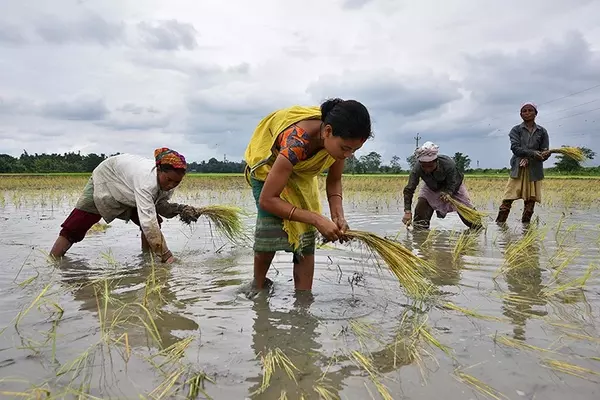

Modi government planning surge in big fertiliser plants to achieve second green revolution. (Photo for representation)
<p>
It is a matter of national pride that India has achieved significant milestones in agricultural production and productivity to ensure food and nutrition security to a billion-plus population. As per the official data sheet, our country has achieved food grain production of 296 million tonnes (MT) in 2019-20 and is to achieve 300 MT of production during 2020-21. The production of fruits and vegetables has also grown at an average of 5 percent per annum during the period 2014-15 to 2019-20. The availability of other nutritional food items like eggs, meat, fish and dairy items, has also witnessed tremendous growth.</p>
<p>
The spectacular success of attaining self-reliance in food grain production and nutrition in the country has been achieved through a combination of factors, like the entrepreneurial spirit, strenuous labour and indomitable willpower of 140 million farmers, the various farmers&rsquo; welfare and productivity augmenting policies of the Central and state governments, and the positive role played by other important stakeholders engaged in Agri-input, Agri-marketing and Agri-processing sectors. The contribution of timely supply of quality Agri-inputs like seeds, pesticides, weedicides, fertilisers (both traditional and manufactured) is quite significant in enhancing production and productivity in the agricultural sector. Of all the agricultural inputs,</p>
<p>
Fertiliser is one of the most crucial ingredients for ensuring food, nutrition security.</p>
<p>
Fertilisers constitute 20 percent of the cost of cultivation of various crops, according to the Commission for Agricultural Cost and Prices (CACP). Hence, the importance of the fertiliser sector in ensuring food and nutrition security is well recognized. The alternatives to manufactured chemical fertilisers have been tried but at least at present, there is no proven assurance that these would substantially replace chemical fertilisers. It is neither feasible nor desirable, keeping in view food and nutrition security in countries like India.</p>
<p>
The urea sector contributes significantly to fertiliser production and consumption in the country. It accounts for 60 percent of the total fertiliser consumption and 50 percent of the total fertiliser imports in terms of volume. The total requirement of urea in the country was 340 LMT during 2019-20, out of which 92.40 LMT was imported as the domestic production capacity is 220 LMT. However, a total of 245 LMT of urea was produced in India during FY 2019-20, implying a capacity utilisation of 113.60 percent.</p>
<p>
Further, as part of securing significant domestic production, the government has also taken the bold decision of establishing brownfield urea manufacturing units through joint ventures (JV) formed by several Navaratna and Mini ratna Public Sector Undertakings (PSUs).</p>
<p>
The first such JV is Ramagundam Fertiliser and Chemical Ltd (RFCL), owned jointly by Rashtriya Chemicals and Fertilisers Ltd (RCF), Engineers India Ltd (EIL), National Fertilisers Ltd (NFL) and FCIL. The plant has been commissioned with an annual production capacity of 12.7 lakh MT of urea. The RFCL plant is located in the Karimnagar district of Telangana .</p>
<p>
The government of India has also facilitated the formation of another JV company Hindustan Urvarak &amp; Rasayan Limited (HURL) with Coal India Ltd (CIL), NTPC, and Oil India Ltd (OIL) as major shareholders and HFCL and FICL as minority shareholders. It is executing three brownfield urea manufacturing units at Gorakhpur in UP, Barauni in Bihar and Sindri in Jharkhand. The estimated project cost of these three plants is more than RS. twenty thousand crores . It is heartening to know that the Gorakhpur plant was inaugurated by PM Modi in the first week of December 2021, and the other two units are expected to start producing much needed urea fertilizer in the beginning of the year 2022, i.e., within the next couple of months.</p>
<p>
India&#39;s dependency on import, at present, is to the extent of 25% of our requirement of Urea, 90% in case of Phosphates, either as raw material or finished fertilisers (DAP/MAP/TSP) and 100% in case of Potash. The Government has been encouraging Indian Companies to establish Joint Ventures abroad in Countries which are rich in fertiliser resources for production facilities with buy back arrangements and to enter into long term agreements for supply of fertilisers and fertiliser inputs to India. Further, government of India has also been working with the goal of having access to acquisition of the raw materials for fertilisers from abroad</p>
<p>
The objective of the Government policy is to maximise indigenous production of nitrogenous fertilisers based on utilisation of indigenous feedstock to reach self-sufficiency in urea production, to ensure easy availability of fertilisers to the farmers at affordable prices and to promote balanced nutrient application which is essential for sustained agricultural growth. There are 32 urea manufacturing units in the country with a total re-assessed capacity of 232.94 Lakh Metric Tonnes&nbsp; per Annum (LMTPA). Out of 32 urea manufacturing units, 30 urea units are using natural gas as feedstock and 2 urea units are using naphtha as feedstock. It is expected that with the commissioning of all the under-construction brownfield urea projects in the public sector, India would achieve near self-sufficiency in meeting the demand of urea for its own consumption.</p>
<p>
<strong>Also Read:&nbsp;</strong>&nbsp;<a href="https://www.indianarrative.com/india-news/gorakhpur-fertiliser-plant-boost-to-food-security-and-key-to-the-rise-of-purvanchal-133946.html">Gorakhpur fertiliser plant- boost to food security and key to the rise of Purvanchal</a></p>
<p>
<strong>(Vijay Shankar Pandey retired from the Indian Administrative Service. He has an established record of raising his voice against corruption in public life. Views expressed are personal)</strong></p>
Prime Minister Narendra Modi interacted with members of the Indian diaspora here on Wednesday as…
The city of Hamburg in Germany is set to host the 11th edition of India…
The International Atomic Energy Agency (IAEA) has confirmed that two Iranian centrifuge production facilities, TESA…
The human rights department of the Baloch National Movement (BNM), Paank, has strongly condemned the…
In a major boost to India's coastal defence capabilities, the Indian Navy on Wednesday commissioned…
Volker Turk, the UN High Commissioner for Human Rights, on June 17 expressed concern over…